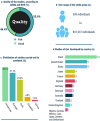Quality of life assessment instruments for adults: a systematic review of population-based studies
- PMID: 32605649
- PMCID: PMC7329518
- DOI: 10.1186/s12955-020-01347-7
Quality of life assessment instruments for adults: a systematic review of population-based studies
Abstract
Background: Against a backdrop of population aging and improving survival rates for chronic noncommunicable diseases (CNCD), researchers are placing growing emphasis on health-related quality of life (HRQoL). The aim of this study was to identify the QoL assessment instruments used in population-based studies with adults conducted around the world.
Methods: A systematic review of original research published in all languages between 2008 and 2018 was conducted. Systematic reviews and meta-analyses were excluded.
Results: Sixty-three articles (38.1% conducted in the Americas) fitted the eligibility criteria. Based on the AHRQ checklist for cross-sectional studies and the Newcastle-Ottawa scale for cohort studies, methodological quality was shown to be fair in the majority of studies (55.6%) and good in 44.4%. The country with the highest number of publications was Brazil (20.6%). Twelve types of generic instruments and 11 specific instruments were identified. The generic instrument SF-36 was the most frequently used measure (33.3% of studies). In-home interviewing was exclusively used by 47.6% of the studies, while 39 studies (61.9%) reported the use of self-administered questionnaires. Over two-thirds of the studies (34.9%) used questionnaires to investigate the association between chronic diseases and/or associated factors.
Conclusions: It was concluded that the wide range of instruments and modes of questionnaire administration used by the studies may hinder comparisons between population groups with the same characteristics or needs. There is a lack of research on QoL and the factors affecting productive capacity. Studies of QoL in older persons should focus not only on the effects of disease and treatment, but also on the determinants of active aging and actions designed to promote it. Further research is recommended to determine which QoL instruments are best suited for population-based studies.
Keywords: Health-related quality of life; Population surveys; Quality of life; Systematic review.
Conflict of interest statement
The authors declare that they have no competing interests.
Figures




References
-
- Group TW The World Health Organization quality of life assessment (WHOQOL): development and general psychometric properties. Soc Sci Med. 1998;46(12):1569–1585. - PubMed
-
- Vagetti GC, Moreira NB, Barbosa Filho VC, de Oliveira V, Cancian CF, Mazzardo O, et al. Domínios da qualidade de vida associados à percepção de saúde: um estudo com idosas de um programa de atividade física em bairros de baixa renda de Curitiba, Paraná. Brasil Cien Saude Colet. 2013;18(12):3483–3493. - PubMed
-
- de Queiroz FA, Pace AE, dos Santos CB. Adaptación Cultural Y Validación Del Instrumento Diabetes – 39 ( D-39 ): Versión Para Brasileños Con Diabetes Mellitus Tipo 2 - Fase 1 1 Cross-Cultural Adaptation and Validation of the Instrument Diabetes – 39 ( D-39 ): Brazilian Version for Type 2 Diabet. Rev Latino Am Enferm. 2009;17(5):708–715. - PubMed
-
- Campolina AG, Dini PS, Ciconelli RM. Impacto da doença crônica na qualidade de vida de idosos da comunidade em São Paulo ( SP , Brasil ) The impact of chronic disease on the quality of life of the elderly in São Paulo (SP, Brazil) Ciência e Saúde Coletiva. 2011;16(6):2919–2925. - PubMed
-
- Landeiro G, Pedrozo C, Gomes M, Oliveira E. Revisão sistemática dos estudos sobre qualidade de Vida indexados na base de dados Scielo systematic review of studies on quality of life indexed on the Scielo database. Ciênc saúde coletiva. 2011;16(10):4257–4266. - PubMed
Publication types
MeSH terms
Grants and funding
LinkOut - more resources
Full Text Sources

